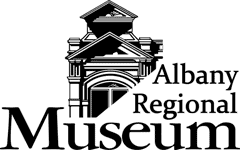By Cathy Ingalls, Albany Regional Museum board member
The Great Fraternal Movement in America flourished from 1865-1918, when one in every five men belonged to one or more fraternal societies.
Several of those groups were active in Albany, and buildings where at least two of the societies met still stand downtown.
The Freemason’s St. John’s Lodge No. 17 meets in the Masonic Building, 425 First Ave. N.W., while Knights of Pythias members gathered upstairs at Third and Lyon streets, the structure that once housed the White Rose floral shop.
The Albany Pythians appear to have disbanded several years ago.
Between the late 19th and early 20th centuries, fraternal and secret societies dominated the social life of much of the United States, according to a 2006 article in the Business and The Brethren Scottish Rite Journal. Those societies influenced behavior, how members’ spent their time and money, and it was important to those men to be perceived well by others and themselves, the article states.
As the number of secret societies grew, a separate industry sprang up to supply lodges with products, publications, equipment, furnishings and regalia.
Around the Civil War period, there were two Masonic lodges in Albany, one consisting of Southern sympathizers and the other reflected a Union viewpoint. Both met at different times at the lodge, but in 1904 the two lodges joined together, taking the St. John’s name.
Notable members of the Albany lodge include Delazon Smith, a former United States senator, attorney J.K. Weatherford, for which Weatherford Hall on the Oregon State University campus is named, and a former governor, George Chamberlain.
The late Jonathon Strong, Masonic Lodge trustee, looks at gallery of past exalted rulers
Nationally, members included presidents George Washington, James Monroe, Andrew Jackson, James K. Polk and Teddy Roosevelt. Others on the roster were Generals Omar Bradley and John Pershing, Alamo defender Davy Crockett and actor Clark Gable.
Today as always, Masons probably founded during the Middle Ages, work to improve communities by helping others, particularly children and the elderly.
The Knights of Pythias was started in Washington, D.C., as a militaristic fraternal society about 1864 by Justus Henry Rathbone to aid those affected by the Civil War. There were thousands of members by the 1870s, many joining because of the military aspects as participants wore uniforms, carried ornate swords and paraded publicly as a ceremonial unit.
Within 30 years of forming, the Knights of Pythias was the third largest fraternal organization in the United States.
The organization stresses friendship, charity and benevolence and uses the Bible and the American flag in its rituals.
Well-known members include Presidents Franklin Roosevelt, William McKinley and Warren Harding. Others were Vice President Hubert Humphrey and orator William Jennings Bryan.
According to paperwork on file at the city of Albany and the Albany Regional Museum, the three-story, 60- by 100-foot Masonic building was constructed in 1880 in the American Renaissance-style. The lodge retains use of the top two floors, while storefronts are on the street level.
The Masonic lodge sits on a brick foundation and at one time had a clock tower but it was removed when the adjacent building was annexed to the lodge section and a symmetrical façade was added.
In 1913 the building was remodeled under the direction of noted Oregon architect Charles Burgraff, who lived and worked in Albany between 1899 and 1933. He also designed the Knights of Pythias building constructed in 1913 along with at least six courthouses, various office buildings, hospitals and private residences around the state plus Albany’s Central School and the town’s former junior and senior highs.
Burgraff designed the three-story Pythias building in an Italianate-style with the 14,342-square-foot first floor dedicated to commerce. Large windows were installed in the ground floor but many have been bricked in.
Masonic Hall Ritual Room
The second floor contained apartments that ringed the periphery of the building. Laurel Lodge No. 7 organized in 1879 met in a room built in the center of that floor. A balcony was constructed to the rear of the meeting area.
Windows in the meeting room open onto hallways and are above eye level. They let in light and allowed air to circulate.
Floors and woodwork in the building need refinishing but are largely intact, according to Robert Dortignacq of the planning, architectural and conservation firm in Portland that the city of Albany has used for consultant work.
“The building has a high degree of historic integrity,” he said in his 2013 report to the city.
Early on, Hulbert-Ohling Hardware Co. occupied the main floor of the structure. In the 1920s, Mountain States Power Co. took over the space and its successor, Pacific Power and Light moved in during the 1970s.
Later, Home Federal Administration offices were there along with Patterson Furniture.
In June 1992, Pacific First Bank sought permission from the city to tear down the building but the city’s landmarks commission required that the bank agree to a one- year stay on its plans. The building continues to stand.
At the time, the estimate to refurbish the building was $1.3 million while the cost to tear it down and create a parking lot was thought to be about $650,000.
For more information about the Masons and Pythians and the two buildings, visit the Albany Regional Museum, 136 Lyon St. S.


